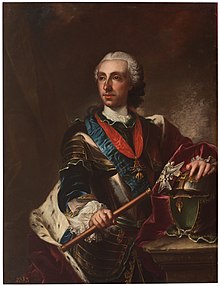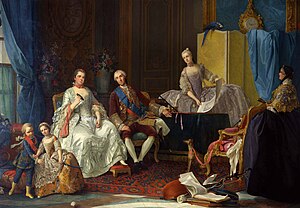| Philip | |||||
|---|---|---|---|---|---|
 Portrait by Francesco Carlo Rusca, 1745 Portrait by Francesco Carlo Rusca, 1745 | |||||
| Duke of Parma, Piacenza and Guastalla | |||||
| Reign | 18 October 1748 – 18 July 1765 | ||||
| Predecessor | Maria Theresa (Parma and Piacenza) Giuseppe Maria Gonzaga (Guastalla) | ||||
| Successor | Ferdinand | ||||
| Born | (1720-03-15)15 March 1720 Royal Alcazar, Madrid, Spain | ||||
| Died | 18 July 1765(1765-07-18) (aged 45) Alessandria, Kingdom of Sardinia | ||||
| Burial | Sanctuary of Santa Maria della Steccata | ||||
| Spouse |
Louise Élisabeth of France
(m. 1739; died 1759) | ||||
| Issue | |||||
| |||||
| House | Bourbon-Parma (founder) | ||||
| Father | Philip V of Spain | ||||
| Mother | Elisabeth Farnese | ||||
| Religion | Roman Catholicism | ||||
| Signature |  | ||||
Philip (Spanish: Felipe, Italian: Filippo; 15 March 1720 – 18 July 1765) was Duke of Parma from 18 October 1748 until his death in 1765. A Spanish infante by birth, he was born in Madrid as the second son of King Philip V and Queen Elisabeth. He became Duke of Parma as a result of the 1748 Treaty of Aix-la-Chapelle. The duchy had earlier been ruled by Philip's elder brother, the future Charles III of Spain, and by their maternal ancestors. Philip founded the House of Bourbon-Parma, a cadet line of the House of Bourbon. He was a first cousin and son-in-law of the French king Louis XV.
Life
Born at the Royal Alcazar in Madrid as Felipe de Borbón y Farnesio, he was the third child and second son of Philip V of Spain and his wife, Elisabeth Farnese.
He was raised in Madrid and as a child showed more interest in art than in politics. He was also the 12th Count of Chinchón and Grandee of Spain First Class with a coat of arms of Bourbon after the alienation with royal authorization in 1738 of the 11th Count of Chinchón, Don Jose Sforza-Cesarini, Duke of Canzano, a title he later ceded to his brother Louis in 1754.

His mother came from the family of Farnese, which had ruled the Duchy of Parma, Piacenza and Guastalla for many generations. The duchy had been ruled between 1731 and 1736 by his elder brother Charles, but was exchanged with Austria for The Two Sicilies after the War of Polish Succession. Twelve years later, in the Treaty of Aix-la-Chapelle (1748), Austria lost the duchy and Philip became the new duke, founding the House of Bourbon-Parma.
As part of the Second Treaty of Versailles (1757) between Austria and France, it was intended that Philip would become king of the Southern Netherlands in a deal that would see French troops occupy key positions in the country – however this arrangement was repudiated by the subsequent Third Treaty of Versailles and Philip continued in Parma.
The Duchy of Parma was ruined by many years of warfare, and in 1759 Philip named the able Frenchman Guillaume du Tillot as his minister to restore the economy. Philip was an enlightened ruler who stimulated education and philosophy, attracting personalities like Étienne Bonnot de Condillac and Alexandre Deleyre.
Marriage

Philip married his first cousin once removed Princess Louise Élisabeth of France in Alcalá de Henares, Spain on 25 October 1739. They had three children.
- Princess Isabella of Parma (31 December 1741 – 27 November 1763) – she married Marie Antoinette's older brother, the Austrian emperor, Archduke Joseph of Austria. She had issue, but all her children died in childhood.
- Ferdinand I, Duke of Parma (20 January 1751 – 9 October 1802) – he succeeded his father as Duke of Parma and married Archduchess Maria Amalia of Austria and left issue.
- Princess Luisa Maria of Parma (9 December 1751 – 2 January 1819) married Charles IV of Spain and left issue.
Their marriage was an unhappy one, and Louise Elisabeth died of smallpox at the age of 32 in 1759. Philip died unexpectedly on 18 July 1765 in Alessandria, Sardinia, after having accompanied his daughter Maria Luisa on her way to Genoa, where she sailed for Spain to marry Infante Charles. Through Philip's daughter Maria Luisa, he is an ancestor of the Bourbons of Spain, the Bourbons of the Two Sicilies, and the House of Orléans.
Honours
 France: Knight of the Order of the Holy Spirit (22 March 1736)
France: Knight of the Order of the Holy Spirit (22 March 1736)
Ancestors
| Ancestors of Philip, Duke of Parma |
|---|
Heraldry
- Heraldry of Philip, Duke of Parma
-
 Coat of arms as Infante of Spain
Coat of arms as Infante of Spain
-
 Coat of arms as Duke of Parma, Piacenza and Guastalla
Coat of arms as Duke of Parma, Piacenza and Guastalla
References
- Genealogie ascendante jusqu'au quatrieme degre inclusivement de tous les Rois et Princes de maisons souveraines de l'Europe actuellement vivans [Genealogy up to the fourth degree inclusive of all the Kings and Princes of sovereign houses of Europe currently living] (in French). Bourdeaux: Frederic Guillaume Birnstiel. 1768. p. 8.
- Balechou, Jean Joseph. "Don Philippe, Infant d'Espagne" (in Portuguese). National Library of Portugal. Retrieved 18 March 2013.
- "Parma, Fernando I de Borbón, Duque de (1751-1802)". Ex-Libris Database (in Spanish). Royal Library of Spain. Retrieved 18 March 2013.
| Philip, Duke of Parma House of Bourbon-ParmaCadet branch of the House of BourbonBorn: 15 March 1720 Died: 18 July 1765 | ||
| Regnal titles | ||
|---|---|---|
| Preceded byMaria Theresa (Parma and Piacenza) Giuseppe Maria Gonzaga (Guastalla) |
Duke of Parma, Piacenza and Guastalla 1748–1765 |
Succeeded byFerdinand |
| Spanish nobility | ||
| Preceded byPhilip V of Spain | Count of Chinchón 1738–1754 |
Succeeded byInfante Luis of Spain |
| Preceded byPhilip V of Spain | Duke of Canzano 1748–1765 |
Succeeded byInfante Luis of Spain |
| Infantes of Spain | |
|---|---|
| The generations indicate descent from Carlos I, under whom the crowns of Castile and Aragon were united, forming the Kingdom of Spain. Previously, the title Infante had been largely used in the different realms. | |
| 1st generation | |
| 2nd generation | |
| 3rd generation | |
| 4th generation | |
| 5th generation |
|
| 6th generation |
|
| 7th generation | |
| 8th generation | |
| 9th generation | |
| 10th generation | |
| 11th generation | |
| 12th generation | |
| 13th generation | |
| 14th generation | |
| 15th generation | |
| 16th generation |
|
| |
| Dukes of Parma | |
|---|---|

| |
| Held in pretence, no implied sovereignty:
| |
| * denotes titular Duke |
- 1720 births
- 1765 deaths
- 18th-century Spanish nobility
- 18th-century dukes of Parma
- House of Bourbon-Parma
- Dukes of Guastalla
- Princes of Parma and Piacenza
- Spanish infantes
- Knights of the Golden Fleece of Spain
- Spanish generals
- House of Bourbon
- Spanish people of the War of the Austrian Succession
- Burials at the Sanctuary of Santa Maria della Steccata
- Grandees of Spain
- Sons of kings
- Children of Philip V of Spain
- Sons of counts